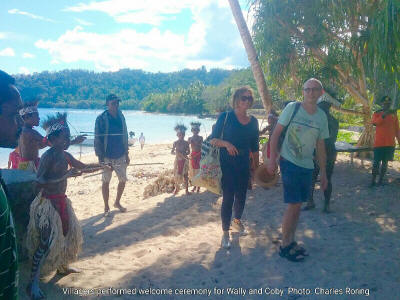Two days ago (29 September 2019) I left Sorong for Waisai town by a morning ferry. I planned to go to Yenbekaki village in north -eastern region of Waigeo. Arriving in the capital of Raja Ampat regency, I went to the lodge where Wally and Coby stayed. They were two volunteers from the SDSP Foundation in the Netherlands. They came to Raja Ampat to help build clean water facility for the Turtle Conservation Program. We discussed things related to the purchase of the materials, and the transportation to the village and the construction of clean water, and toilet facilities for the turtle conservation program at Warebar beach. The facilities will support the villagers in serving tourists who visit Yenbekaki.

Two villagers, Yusup Mayor (the coordinator of turtles conservation innitiatives and Simon Bonsapia (head of the deliberation committee of Yenbekaki), from Yenbekaki came and informed us that the speedboat was ready. So, we packed our things and then headed to WTC beach. Fifteen minutes later our speed boat departed.

The sea was calm. Our speedboat was moving fast on the water. When we entered the waters of Yensner, there were some sandbank areas whose waters were shallow. Our speedboat has to make several manuevers to avoid them. We passed by Mamiaef island and went through the waters between Urbinas Sopen and Waim island. We could feel some waves at Cape Pamali in front of Yenbekaki. The south wind was getting weaker. The waves were not big, our boat continued moving in high speed. One of the engines suddenly stopped when we were around 1 mile Yenbekaki village. The mechanic who was with us tried to repair it. Unfortunately, it could not be started. We decided to continue our trip to the village with only 1 engine.

Villagers of Yenbekaki were at the beach. They had prepared a welcome ceremony for Wally and Coby. A Papuan man whose skin were fully covered in mud ran towards us. He was holding bow and arrow. He acted as if he was a warrior from Yenbekaki who came to meet strangers who landed on his land. Later, children who also wore traditional costumes came to meet us. Girls from the village started to dance. Local musicians played guitars and drums and sang folk songs. It was a very good ceremony. We entered the village walking towards to the frontyard of the church. A villager made a prayer to give thanks to God for our safe journey to Yenbekaki.

At night, we discussed things related to handicraft making. Coby had bought a lot of beads and bundles of thread in several colors. She wanted to use them to train mothers and girls in the village to make bracelet and necklace.
The next morning (30 September 2019) mothers and girls gathered at the beach to attend the training. Coby used her cell phone to show pictures of necklaces made of beads and also pictures of how the threads should be plaited to make bracelets. Because some of the villagers had smartphones, Coby gave them the pictures using bluetooth. Fathers and young men also enthusiastically joined the trainings. At first, they they were confused with the tangled braid pattern but later after more practices, they were able to make better bracelets. The bead necklace and bracelets are easier to be made. Young boys and girls could make them faster. One or two of the mother can even make more complicated crochet works such as cell phone pouches.
The training was going on until around 15.30. The villagers are happy to practice this type of handicraft making. I could feel the atmosphere of friendship and togetherness while watching the beautiful scenery of the blue sea and coastal land of Waigeo.
After that, we had a beach walk to the eastern side of the village. The white sand and the green forest looked very beautiful. We saw Palm Cockatoo, Willie Wagtail, Brahminy Kite, Radjah Shelduck and Eastern Yellow Wagtail. I made pictures of some of the birds. There were also beautiful birdwing butterflies that were flying around.
In the evening, we together with some villagers did some beach clean-up works We collected plastic, dry leaves, and other wood materials that were scattered along the beach and burned them. After that we took a rest.
At around 23.00, Yusup Mayor, the head of the Turtle Conservation Program woke me up. He said that there was a turtle landing at the beach of the village. I immediately rose from my bed, grabbed my camera and met him. We walked fast to the beach. It was around 150 meters from the house where I Wally and Coby stayed. When we arrived the turtles were still delivering the eggs. It was surrounded by some villagers who were also taking pictures and making videos of the turtles. My camera was Canon 200D with Tamron 150-600 mm G2 telephoto lense. I had to stand quite far from the turtles in order to take pictures of her. It was a very nice experience.
Yenbekaki is a village in north-east region of Waigeo island. It has got black and white sandy beach. The black sand, called Warebar, is the nesting ground of Leatherback, Olive Ridley, Hawksbill and Green Turtles. The beach is located on the other side of Yenbekaki Bay across from the village. Villagers run Turtle Conservation Program at this beach. They have got a post for monitoring and protecting the turtles at this beach. Tourists can visit the beach and stay in the post to see turtles at the beach, birds and other wild animals in the forest.
The white sandy beach that is the beach-front of Yenbekaki village is the nesting ground of Olive Ridley, Green and Hawksbill turtles. This is written by Charles Roring.